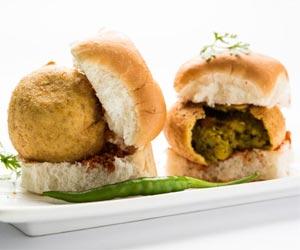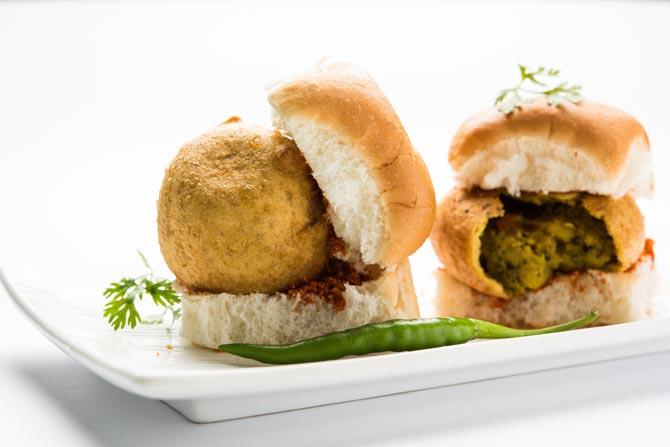Mumbai is not just the city of dreams, but also the hub of street food where every nook and corner offers a whole gamut of dishes to suit your palate and wallet

Mumbai is not just the city of dreams, but also the hub of street food where every nook and corner offers a whole gamut of dishes to suit your palate and wallet - from the tangy 'pani puri' to the spicy 'vada pav'. With a complete mish-mash of snacks available on every roadside in the sprawling metropolis, its distinctive hallmark 'street food' has now turned into meals being eaten "off the streets", feel food experts.
ADVERTISEMENT

Vada pav
Mumbai cuisine is an amalgamation of many other cuisines, they say. When it started out, however, the coastal city was characterised by its seafood as the natives were the 'kolis' or fishermen community, celebrity chef Ranveer Brar tells PTI. "With time and with the advent of other communities, the culinary scene expanded. While Maharashtrian cuisine remains stamped or its influence is seen across the food offered in the city, more individual cuisines developed to meet demands of the migrants from other states, or let's broadly say cultures," he says.
For instance, the Persians introduced their flavours with a chain of Irani cafes. With the influx of South Indians, grew the demand for and popularity of Udupi restaurants. The Gujarati community has an equal stronghold in the culinary scene, he says. 'Pav bhaji' is, of course, the ubiquitous snack and enjoys super popularity. Then there is the 'bhel', in all its variations, the pani puri, the Mumbai veg sandwich, the uniqueness of which comes from its chutney that completely
turns it around, he says. Besides, 'kanda poha' is an amazingly popular breakfast preference, as are 'idlis' and 'masala dosas'. "And, if you are a meat-lover, Mohammed Ali road is a delight, specially around Ramzan. The fares available, the variety and aroma is simply mind-blowing," Brar says.
"Apart from these, North Eastern food in the city is a must-try. Don't miss the momos, pot noodles and thukpas (traditional Tibetan noodle soup)," he says. Hemant Oberoi, the former star chef of the iconic Taj Mahal Palace hotel, says most of the street food in Mumbai came from Gujarati, Maharashtrian and Mangalorean communities. The most popular foods on the streets have been 'ragda patties', 'keema pav', 'pav bhaji', 'baida paratha', 'frankie rolls', 'bhel puri', 'poha' and 'dosa/idli', he says.
"The USP of these items is that they are a complete meal in itself. If you look at vada pav, it's a complete burger, frankie is a roti wrap and so are baida paratha and
dosa. 'Bombay toastie' is a complete sandwich with chutney, tomatoes, onions, cheese and potatoes," says Oberoi. However, Farzana Contractor, the publisher and editor of UpperCrust magazine, says the quality of street food has gone down tremendously, "because when you consider hygiene, it's totally absent." "So, if I had eaten plenty of street food during my school and college days, today, I'm sorry, I don't eat it. So now I've stopped talking about street food and I don't glamorise street food anymore," she says.
"The concept of street food has changed. We now have meals which are served on the streets. They are called street foods, but it's eating off the streets and street food highly compromises on hygiene," Contractor says. "So what I'm saying is it's a complete mishmash... what is street food is everything because unfortunately, food in restaurants has become so expensive that half of the office-going people eat on the streets," says Contractor. "So, eating off the streets, not eating street food, that is the change right now," she says.
Brar says people are reducing the frequency than giving up on fried foods completely. "All said and done, our affair with Indian street food is an ongoing one. But yes, the decision to not binge eat is a conscious one," he says. Delving on the advent of pav, the chef says, "Have to thank the Portuguese for the pav! The humble leavened bread travelled from Goa to Mumbai where it was lapped up and incorporated into the different street foods that also travel upmarket."
Its USP is the affordability and availability. In the days of the Raj, proper bread was more for the privileged and making the pav more popular for everyone else, he says. The vada pav concept started around the 1970s. "Its popularity surged among the commuters as a quick but filling bite on the go. Pav bhaji, on the other hand, featured as early as the 1850s. It became a hit among mill workers who got a wholesome and affordable meal that they could finish off in a short time," he says. "The placement of these pav bhaji stalls were strategic - outside the Cotton Exchange, where traders waited for the cotton prices in the wee hours," the chef says.
However, hygiene is one factor which the people have become conscious about.
"The street food, if you ask me, has never been a healthier option ever. People who want to enjoy a nice spicy snack or a meal hardly look at fried or not fried, though you can have an idli or poha too, which are lighter options, says Oberoi. "We introduced street food in 'sea lounge' and 'shamiana' (at Taj hotel) almost 40 to 50 years back and it was appreciated since some of the guests got very hygienic way prepared street food," he says. Contractor says the first food columns in newspapers
were written by her late husband Behram Contractor aka BusyBee (noted journalist and founder-editor of Afternoon newspaper) in the 60s.
"He discovered all these places with their 'paya' (traditional meat-based dish), 'nalli nihari' (stew of slow-cooked meat), biryani on the roads," she says. On the hygiene quotient, she says, "Certain kind of people would not and should not eat on the streets. Since our stomachs are not cast iron strong." Brar says even in high-profile restaurants and hotels customers often ask for street food, because of the hygiene factor (which is absent on the streets).
 Subscribe today by clicking the link and stay updated with the latest news!" Click here!
Subscribe today by clicking the link and stay updated with the latest news!" Click here!







